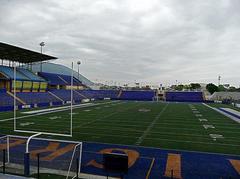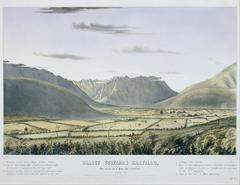
Palacio del Obispado: Visiting Hours, Tickets, and Historical Significance in Monterrey, Mexico
Date: 04/07/2025
Introduction
The Palacio del Obispado, perched atop the Cerro del Obispado in Monterrey, Mexico, stands as a remarkable testament to the region’s colonial legacy, architectural distinction, and evolving cultural identity. Built between 1787 and 1788 as the residence for the Bishop of the Diocese of Linares, this Baroque palace has played significant religious, military, and civic roles throughout its history. Today, it houses the Museo Regional de Nuevo León, offering visitors insight into centuries of local history and providing some of the best panoramic views of Monterrey. Whether you are a history enthusiast, architecture aficionado, or simply seeking an iconic vantage point in the city, the Palacio del Obispado is a must-visit destination. For further details, consult Wikipedia, INAH Mediateca, and Touristlink.
Table of Contents
- Origins and Construction
- Ecclesiastical and Colonial Role
- Military Significance
- Decline, Repurposing, and Restoration
- Architectural Features and Collections
- Visitor Information: Hours, Tickets, and Accessibility
- Symbolic and Cultural Legacy
- Nearby Attractions and Mirador del Obispado
- Preservation and Community Engagement
- Museo Regional de Nuevo León: Exhibitions and Tips
- Frequently Asked Questions
- References
Origins and Construction
The Palacio del Obispado was commissioned by Rafael José Verger, the second bishop of the Diocese of Linares, to serve as an episcopal residence and religious center (Wikipedia; Academia-Lab). Strategically positioned atop Cerro del Obispado (formerly Loma de la Chepe Vera), its location allowed for defensive advantages and impressive city views (Atlas Obscura). The palace exemplifies Spanish colonial Baroque style, with robust limestone construction, a richly carved façade, and a grand dome. The main entrance features a niche intended for Our Lady of Guadalupe, while the thick walls reflect its dual function as both a residence and a fortress (Mexico Desconocido).
Ecclesiastical and Colonial Role
Established as the seat of the Diocese of Linares by royal decree and papal bull, the Palacio del Obispado became the administrative and spiritual center for the region (Wikipedia). Bishop Verger relocated the episcopal seat to Monterrey, recognizing its growing prominence. The palace’s oratory, dedicated to the Virgin of Guadalupe, was adorned with a retablo by Francisco Vallejo in 1783. Notable religious artifacts, including a portrait of Bishop Verger by Juan Alzíbar, are part of its heritage (INAH Mediateca).
Military Significance
The palace’s commanding position made it a focal point during several military conflicts:
- Mexican-American War (1846): Served as a key defensive position in the Battle of Monterrey (Wikipedia; Nomada News)
- Second French Intervention (1864–1866): Used by both republican and imperialist forces.
- Plan de la Noria (1871), Plan de Tuxtepec (1876), and Mexican Revolution (1913–14): Repeatedly adapted for military use (Academia-Lab)
Physical evidence of conflict—such as bullet marks and trenches—remains visible (Nomada News).
Decline, Repurposing, and Restoration
After Mexico’s independence, the palace’s religious function diminished, leading to varied uses:
- Medical Facility: Served as a lazaretto during epidemics (Wikipedia)
- Cabaret: Briefly operated as a cabaret in the 1920s
- Abandonment: Suffered deterioration until restoration began in 1946
In 1956, it reopened as the Museo Regional de Nuevo León, following significant restoration, with ongoing conservation efforts into the late 20th century (Atlas Obscura).
Architectural Features and Collections
The palace is a two-story structure built around a central courtyard. Notable features include:
- Baroque Façade and Dome: Intricate stonework and a prominent dome completed in the 19th century (Mexico Desconocido)
- Oratory: Adorned with historic religious art
- Material: Local limestone and wood (Academia-Lab)
- Museo Regional de Nuevo León: Displays artifacts from pre-Hispanic, colonial, and industrial periods (INAH Mediateca)
Visitor Information: Hours, Tickets, and Accessibility
- Opening Hours: Tuesday to Sunday, 10:00 AM–6:00 PM; closed Mondays and public holidays
- Admission: Approx. $50–$85 MXN; discounts for students, seniors, and free for children under 12 (Nuevo León Travel)
- Tickets: Purchase at entrance or online via the official website
- Guided Tours: Available in Spanish (daily) and English (upon request); group tours should be booked in advance
- Accessibility: Ramps and elevators allow partial access for visitors with reduced mobility, though some historic areas may be less accessible
- Getting There: Reachable by car, taxi, or public transit; walking trails available for hikers; parking on site
- Best Time to Visit: October–April for cooler weather; mornings and late afternoons for best light and fewer crowds
Symbolic and Cultural Legacy
The Palacio del Obispado stands as an enduring symbol of Monterrey’s resilience and transformation. Its layered history—from ecclesiastical seat and fortress to museum and cultural hub—makes it a living archive of Nuevo León’s past (Nomada News). Panoramic views from the palace and the adjacent Mirador del Obispado reinforce its prominence as a city landmark (Atlas Obscura).
Nearby Attractions and Mirador del Obispado
- Mirador del Obispado: Features panoramic city views, French gardens, and Mexico’s second-largest monumental flag (Touristlink)
- Macroplaza: Central city square with historical monuments
- Monterrey Museum of Contemporary Art and Fundidora Park: Both within easy reach of the palace
Preservation and Community Engagement
Ongoing preservation projects maintain the palace’s architectural integrity while adapting it for museum functions. Community involvement and public funding ensure its continued relevance (E-A-A.com). The palace hosts civic ceremonies, exhibitions, and educational programs, fostering a sense of collective identity (la-respuesta.com).
Museo Regional de Nuevo León: Exhibitions and Tips
The museum’s ten exhibition rooms trace local history chronologically, showcasing colonial art, religious relics, archaeological finds, and modern works (whichmuseum.com). Managed by INAH, the museum maintains high standards of curation (INAH official site).
Visitor Tips:
- Verify current hours and events on the official website
- Combine your visit with other nearby attractions
- Respect site rules, especially regarding photography and artifact handling
- Spanish is the primary language; translation apps or English guides may be helpful
Frequently Asked Questions (FAQ)
What are the visiting hours?
Tuesday to Sunday, 10:00 AM–6:00 PM; closed Mondays.
How much are tickets?
Adults: $50–$85 MXN; discounts for students, seniors, children under 12 free.
Are guided tours available?
Yes, in Spanish daily and in English upon request. Book in advance for groups.
Is the palace accessible for visitors with disabilities?
Partial accessibility via ramps and elevators; some historic areas may be less accessible.
Can I visit the Mirador del Obispado separately?
Yes; it is open to the public and offers spectacular views.
Visuals
References
- Palacio del Obispado – Wikipedia
- INAH Mediateca: Museo Regional de Nuevo León
- Nomada News: La historia del Obispado de Monterrey
- Mexico Desconocido: Palacio del Obispado Monterrey
- Academia-Lab: Enciclopedia Palacio del Obispado
- Touristlink: Mirador del Obispado Overview
- WhichMuseum: Museo Regional de Nuevo León El Obispado
- Nuevo León Travel: Museo Regional de Historia de Nuevo León
- Atlas Obscura: Palacio del Obispado
- E-A-A.com: 10 Best Architectural Buildings in Monterrey
- la-respuesta.com: Patrimonios culturales de Nuevo León
Conclusion and Final Tips
The Palacio del Obispado is a cornerstone of Monterrey’s historical and cultural landscape, embodying centuries of transformation from colonial residence to military fortress and finally to a dynamic regional museum. Visitors can explore a rich collection of artifacts, enjoy breathtaking views, and participate in cultural events. Plan your visit by checking official sources for current hours and ticket information, and consider using guided tours or the Audiala app for an enhanced experience. For updates and special events, follow the museum’s social media channels.
Plan your visit today and experience one of Monterrey’s most treasured landmarks!




